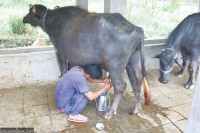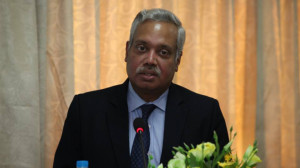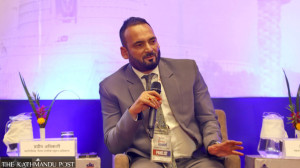National
Two years on, quake-hit families in Rukum West still waiting for reconstruction
Procedural delays and poor coordination between government agencies have forced thousands to remain in makeshift shelters since November 2023.
Mahesh KC
Two years after a devastating earthquake struck western Nepal, reconstruction of damaged houses and infrastructure remains stalled in Rukum West. Thousands of survivors are in limbo.
The earthquake measuring 6.4 on the Richter scale struck Jajarkot on November 3, 2023 and destroyed thousands of homes and public structures in Jajarkot, Rukum West and Salyan districts. But the reconstruction work has barely moved forward in Rukum West. Many survivors continued to live in temporary shelters, uncertain when permanent reconstruction will begin.
The earthquake, with its epicenter in Ramidanda of Jajarkot, killed 157 people and injured hundreds more in the three districts. Despite early promises of swift relief and rebuilding, progress has been painfully slow.
“Two years have passed, and we’re still living in tarpaulin tents,” said Mahendra Satyal, a resident of ward 6 of Athbiskot Municipality in Rukum West. “The government promised help, but it hasn’t understood our suffering. We’ve filled out forms and attended surveys, but nothing happens. How long are we supposed to depend on empty assurances?”
According to the District Administration Office (DAO) of Rukum West, a total of 34,997 households were listed as earthquake beneficiaries in the district. Of them, 31,931 families received Rs 50,000 in two tranches (RS 25,000 each) to build temporary housing. However, 1,065 beneficiaries received only the first tranche, deemed ineligible for the second phase due to incomplete documentation.
The process was supposed to proceed through Detailed Damage Assessment (DDA), which classifies affected households for retrofitting, reconstruction, or relocation based on the extent of damage. However, the DDA process has advanced at a snail’s pace, local officials admit.
“People ask us when their homes will be rebuilt, but we don’t have answers,” said Bir Bahadur Bista, chairperson of Sanibheri Rural Municipality. “First, it took many months for the government to come up with reconstruction and relief guidelines. Then, the damage assessment was delayed. Everything since then has moved painfully slowly.”
Out of nearly 31,000 assessed households, the DAO says DDA has been completed for 30,850 beneficiaries. Yet, the District Disaster Management Committee has so far approved only 4,607 of them. “We are working to approve as many DDA-completed beneficiaries as possible through the committee’s meetings,” said Chief District Officer Dinesh Prasad Thani. “But the data entry and verification work at the local level are moving very slowly.”
In practical terms, this means reconstruction has barely started. “Only four households have so far signed agreements for reconstruction,” Thani confirmed — a negligible number compared to the total assessed cases.
Even among the verified households, delays in paperwork have left 2,001 families waiting for their first tranche of housing aid. The DAO said it has asked local governments to send updated records of beneficiaries who were left out of DDA assessments so they can be forwarded to the National Disaster Risk Reduction and Management Authority (NDRRMA) for inclusion.
Local units claim they did what they could in the early phase—rescue operations, temporary shelters, and relief distribution. But they insist that the responsibility for full reconstruction lies with the federal government. “We’ve done our best within our jurisdiction,” said Rabi KC, mayor of Aathbiskot Municipality. “But reconstruction is the federal government’s responsibility. It must act urgently to move this forward.”
As monsoon rains, winter chills and summer heat repeat for the third time since the quake, thousands in Rukum West continue to endure harsh conditions in makeshift shelters. The slow progress of reconstruction—marred by bureaucratic delays and poor coordination—has left survivors questioning how long they must wait for permanent homes.
The federal government had pledged a ‘reconstruction drive’ similar to that after the 2015 Gorkha earthquake, when large-scale rebuilding was coordinated under the National Reconstruction Authority. However, nearly all of that institutional capacity has since been dissolved, leaving local units to handle complex procedures with limited manpower and unclear directives.
For quake survivors, patience is running thin. “We have survived quakes, rain, and cold — but not neglect,” said Satyal. “If this is the pace of reconstruction, what hope do we have for recovery?”




 6.12°C Kathmandu
6.12°C Kathmandu















